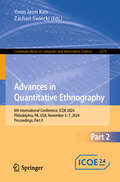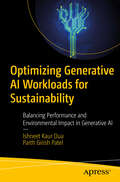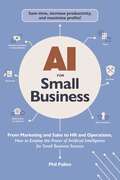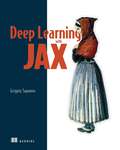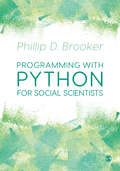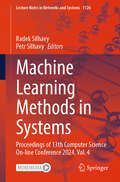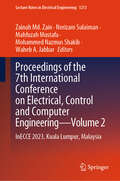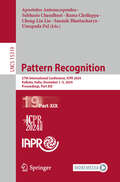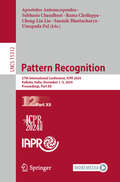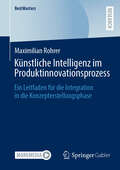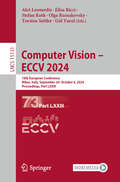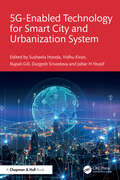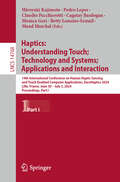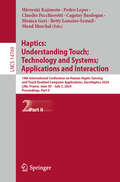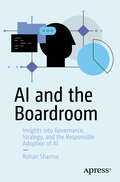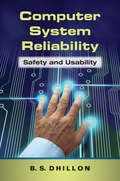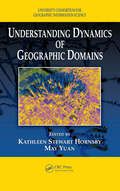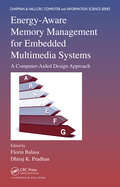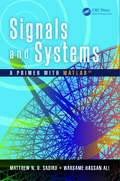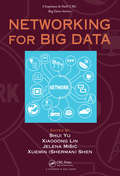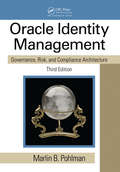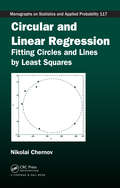- Table View
- List View
Advances in Quantitative Ethnography: 6th International Conference, ICQE 2024, Philadelphia, PA, USA, November 3-7, 2024, Proceedings, Part II (Communications in Computer and Information Science #2279)
by Yoon Jeon Kim Zachari SwieckiThis two-volume set CCIS 2278-2279 constitutes the refereed proceedings of the 6th International Conference on Advances in Quantitative Ethnography, ICQE 2024, held in Philadelphia, PA, USA, during November 3-7, 2024. The 31 full papers and 10 short papers included in this book were carefully reviewed and selected from 82 submissions. They are organized in the following topical sections: Theory and Methods; Teaching and Learning; and Cultural Discourse.
Building Secure PHP Applications: A Comprehensive Guide to Protecting Your Web Applications from Threats
by Satej Kumar SahuLearn how to protect PHP applications from potential vulnerabilities and attacks. As cyberattacks and data breaches continue to rise, it's crucial for developers and organizations to prioritize security in their PHP applications. The book offers an all-encompassing guide to securing PHP applications, covering topics ranging from PHP core security to web security, framework security (with a focus on Laravel), security standards, and protocol security. After examining PHP core security and essential topics, such as input validation, output encoding, secure session management, and secure file handling, you’ll move on to common security risks in PHP applications and provides practical examples to demonstrate effective security measures. From there, you’ll delve into web security, addressing XSS, SQL injection, and CSRF, reviewing in-depth explanations and mitigation techniques. A significant portion of the book focuses on Laravel's built-in security features, guiding readers to avoid common pitfalls. Industry-standard security protocols like HTTP, OAuth, and JSON Web Tokens are explained with demonstrations for how to effectively use them to ensure integrity, confidentiality, and authenticity in web applications. Additionally, protocol security is discussed, including secure communication, file transfer protocols (SFTP), and email handling. Security in cloud and hybrid environments is also discussed. This book's comprehensive and inclusive approach spans a wide range of security topics related to PHP and ensures that no critical areas are overlooked. It goes beyond theoretical concepts by providing practical guidance and actionable steps. It includes code snippets, real-world examples, case studies, and hands-on exercises, enabling you to apply the knowledge gained in practical scenarios. Building Secure PHP Applications provides a holistic approach to security, empowering you to build robust and resilient PHP applications. What You Will Learn Understand industry-recognized security standards and compliance requirements for data protection regulations. Learn the intricacies of Laravel and how to leverage its security features. Integrate security practices throughout the development lifecycle, conducting security testing and reviews and adopting secure deployment and DevOps practices. Conduct forensic analysis and perform post-incident analysis for continuous improvement. Look to the future and discover emerging security threats and techniques to anticipate and mitigate potential security risks. Who This Book Is For Primarily written for developers, security professionals, and webmasters involved in PHP application development. Additionally, this book may be used as a reference for students studying web development, PHP programming or cybersecurity
Optimizing Generative AI Workloads for Sustainability: Balancing Performance and Environmental Impact in Generative AI
by Ishneet Kaur Dua Parth Girish PatelThis comprehensive guide provides practical strategies for optimizing Generative AI systems to be more sustainable and responsible. As advances in Generative AI such as large language models accelerate, optimizing these resource-intensive workloads for efficiency and alignment with human values grows increasingly urgent. The book starts with the concept of Generative AI and its wide-ranging applications, while also delving into the environmental impact of AI workloads and the growing importance of adopting sustainable AI practices. It then delves into the fundamentals of efficient AI workload management, providing insights into understanding AI workload characteristics, measuring performance, and identifying bottlenecks and inefficiencies. Hardware optimization strategies are explored in detail, covering the selection of energy-efficient hardware, leveraging specialized AI accelerators, and optimizing hardware utilization and scheduling for sustainable operations. You are also guided through software optimization techniques tailored for Generative AI, including efficient model architecture, compression, and quantization methods, and optimization of software libraries and frameworks. Data management and preprocessing strategies are also addressed, emphasizing efficient data storage, cleaning, preprocessing, and augmentation techniques to enhance sustainability throughout the data life cycle. The book further explores model training and inference optimization, cloud and edge computing strategies for Generative AI, energy-efficient deployment and scaling techniques, and sustainable AI life cycle management practices, and concludes with real-world case studies and best practices By the end of this book, you will take away a toolkit of impactful steps you can implement to minimize the environmental harms and ethical risks of Generative AI. For organizations deploying any type of generative model at scale, this essential guide provides a blueprint for developing responsible AI systems that benefit society. What You Will Learn Understand how Generative AI can be more energy-efficient through improvements such as model compression, efficient architecture, hardware optimization, and carbon footprint tracking Know the techniques to minimize data usage, including evaluation, filtering, synthesis, few-shot learning, and monitoring data demands over time Understand spanning efficiency, data minimization, and alignment for comprehensive responsibility Know the methods for detecting, understanding, and mitigating algorithmic biases, ensuring diversity in data collection, and monitoring model fairness Who This book Is For Professionals seeking to adopt responsible and sustainable practices in their Generative AI work; leaders and practitioners who need actionable strategies and recommendations that can be implemented directly in real-world systems and organizational workflows; ML engineers and data scientists building and deploying Generative AI systems in industry settings; and researchers developing new generative AI techniques, such as at technology companies or universities
Data Science Solutions on Azure: The Rise of Generative AI and Applied AI
by Julian Soh Priyanshi SinghThis revamped and updated book focuses on the latest in AI technology—Generative AI. It builds on the first edition by moving away from traditional data science into the area of applied AI using the latest breakthroughs in Generative AI. Based on real-world projects, this edition takes a deep look into new concepts and approaches such as Prompt Engineering, testing and grounding of Large Language Models, fine tuning, and implementing new solution architectures such as Retrieval Augmented Generation (RAG). You will learn about new embedded AI technologies in Search, such as Semantic and Vector Search. Written with a view on how to implement Generative AI in software, this book contains examples and sample code. In addition to traditional Data Science experimentation in Azure Machine Learning (AML) that was covered in the first edition, the authors cover new tools such as Azure AI Studio, specifically for testing and experimentation with Generative AI models. What's New in this Book Provides new concepts, tools, and technologies such as Large and Small Language Models, Semantic Kernel, and Automatic Function Calling Takes a deeper dive into using Azure AI Studio for RAG and Prompt Engineering design Includes new and updated case studies for Azure OpenAI Teaches about Copilots, plugins, and agents What You'll Learn Get up to date on the important technical aspects of Large Language Models, based on Azure OpenAI as the reference platform Know about the different types of models: GPT3.5 Turbo, GPT4, GPT4o, Codex, DALL-E, and Small Language Models such as Phi-3 Develop new skills such as Prompt Engineering and fine tuning of Large/Small Language Models Understand and implement new architectures such as RAG and Automatic Function Calling Understand approaches for implementing Generative AI using LangChain and Semantic Kernel See how real-world projects help you identify great candidates for Applied AI projects, including Large/Small Language Models Who This Book Is For Software engineers and architects looking to deploy end-to-end Generative AI solutions on Azure with the latest tools and techniques.
AI for Small Business: From Marketing and Sales to HR and Operations, How to Employ the Power of Artificial Intelligence for Small Business Success (AI Advantage)
by Phil PallenAn essential guide for small business owners and entrepreneurs looking to use artificial intelligence to automate tasks, improve customer service, make better decisions, grow their businesses faster, and stay ahead of the AI curve.ChatGPT, machine learning, automation, natural language processing. Every day, it seems like there is a new AI term to learn and a new promise of how it will improve your work. But with tons of conflicting information, small business owners are left wondering exactly how to leverage AI technology to grow and, more importantly, stay competitive with larger companies. Cutting through the buzzwords and media frenzy, AI for Small Business is the road map to take you from overwhelmed to empowered. Opening with simple explanations of AI basics and clarification of myths, you are empowered to assess your goals to create a comprehensive AI strategy for your business—including information on selecting tools, a timeline for implementation, and ideas for scaling systems. This essential guide then walks you through practical AI applications for each department, informing you how to use AI to automate tasks, make better decisions, and grow your business in all areas including: -Sales -Marketing -Social media and content creation -Customer service -Finance and accounting -Operations and logistics -Human resources and talent management -Data analysis and decision-making -Security and legal compliance -R&D and innovation Author Phil Pallen is a brand strategist who uses his AI expertise to help hundreds of businesses scale and grow profits. In AI for Small Business, case studies from Pallen&’s successful clients illustrate how real small business owners are applying AI technology in various ways. Plus, ready-to-try prompt sidebars and specific product recommendations allow you to start employing the power of AI in real time.
Deep Learning with JAX
by Grigory SapunovAccelerate deep learning and other number-intensive tasks with JAX, Google&’s awesome high-performance numerical computing library.The JAX numerical computing library tackles the core performance challenges at the heart of deep learning and other scientific computing tasks. By combining Google&’s Accelerated Linear Algebra platform (XLA) with a hyper-optimized version of NumPy and a variety of other high-performance features, JAX delivers a huge performance boost in low-level computations and transformations. In Deep Learning with JAX you will learn how to: • Use JAX for numerical calculations • Build differentiable models with JAX primitives • Run distributed and parallelized computations with JAX • Use high-level neural network libraries such as Flax • Leverage libraries and modules from the JAX ecosystem Deep Learning with JAX is a hands-on guide to using JAX for deep learning and other mathematically-intensive applications. Google Developer Expert Grigory Sapunov steadily builds your understanding of JAX&’s concepts. The engaging examples introduce the fundamental concepts on which JAX relies and then show you how to apply them to real-world tasks. You&’ll learn how to use JAX&’s ecosystem of high-level libraries and modules, and also how to combine TensorFlow and PyTorch with JAX for data loading and deployment. About the technology Google&’s JAX offers a fresh vision for deep learning. This powerful library gives you fine control over low level processes like gradient calculations, delivering fast and efficient model training and inference, especially on large datasets. JAX has transformed how research scientists approach deep learning. Now boasting a robust ecosystem of tools and libraries, JAX makes evolutionary computations, federated learning, and other performance-sensitive tasks approachable for all types of applications. About the book Deep Learning with JAX teaches you to build effective neural networks with JAX. In this example-rich book, you&’ll discover how JAX&’s unique features help you tackle important deep learning performance challenges, like distributing computations across a cluster of TPUs. You&’ll put the library into action as you create an image classification tool, an image filter application, and other realistic projects. The nicely-annotated code listings demonstrate how JAX&’s functional programming mindset improves composability and parallelization. What's inside • Use JAX for numerical calculations • Build differentiable models with JAX primitives • Run distributed and parallelized computations with JAX • Use high-level neural network libraries such as Flax About the reader For intermediate Python programmers who are familiar with deep learning. About the author Grigory Sapunov holds a Ph.D. in artificial intelligence and is a Google Developer Expert in Machine Learning. The technical editor on this book was Nicholas McGreivy. Table of Contents Part 1 1 When and why to use JAX 2 Your first program in JAX Part 2 3 Working with arrays 4 Calculating gradients 5 Compiling your code 6 Vectorizing your code 7 Parallelizing your computations 8 Using tensor sharding 9 Random numbers in JAX 10 Working with pytrees Part 3 11 Higher-level neural network libraries 12 Other members of the JAX ecosystem A Installing JAX B Using Google Colab C Using Google Cloud TPUs D Experimental parallelization
Programming with Python for Social Scientists
by Phillip BrookerAs data become ′big′, fast and complex, the software and computing tools needed to manage and analyse them are rapidly developing. Social scientists need new tools to meet these challenges, tackle big datasets, while also developing a more nuanced understanding of - and control over - how these computing tools and algorithms are implemented. Programming with Python for Social Scientists offers a vital foundation to one of the most popular programming tools in computer science, specifically for social science researchers, assuming no prior coding knowledge. It guides you through the full research process, from question to publication, including: the fundamentals of why and how to do your own programming in social scientific research, questions of ethics and research design, a clear, easy to follow ′how-to′ guide to using Python, with a wide array of applications such as data visualisation, social media data research, social network analysis, and more. Accompanied by numerous code examples, screenshots, sample data sources, this is the textbook for social scientists looking for a complete introduction to programming with Python and incorporating it into their research design and analysis.
Graphic Design Portfolio 2024: InDesign, Illustrator & Photoshop
by Against The ClockAgainst The Clock Super Popular Project-Based Series of books designed so that you can Learn while you're building real-world projects. The tight integration between different Adobe applications makes it easier than ever to create professional design for print. This book provides a solid foundation in the three most popular software applications — Adobe Photoshop 2024, Adobe Illustrator, and Adobe InDesign. The projects in this book were designed to represent a range of jobs you will likely encounter during your career in graphic design. In this Photoshop 2024 Book, you will learn to: Customize and manage the user interface in Adobe CC applications to enhance productivity. Define appropriate file settings and resolution for a variety of different print jobs. Use Photoshop software’s powerful controls for compositing images and graphics, correcting colors, adjusting lighting, and repairing visual damage in images. Use Illustrator’s enhanced toolset to create custom vector graphics from both basic shapes and complex Bézier curves. Use InDesign’s sophisticated options to combine text, colors, images, and graphics into finished compositions with settings that are appropriate for commercial printing.
Machine Learning Methods in Systems: Proceedings of 13th Computer Science On-line Conference 2024, Vol. 4 (Lecture Notes in Networks and Systems #1126)
by Radek Silhavy Petr SilhavyThis book requires an in-depth exploration of machine learning and its integration into system engineering. This book presents contemporary research methodologies, with a strong focus on the innovative application of machine learning techniques in developing and optimizing systems. It includes the meticulously reviewed proceedings from the Machine Learning Methods in Systems session of the 13th Computer Science Online Conference 2024 (CSOC 2024), held virtually in April 2024.
Proceedings of the 7th International Conference on Electrical, Control and Computer Engineering—Volume 2: InECCE 2023, Kuala Lumpur, Malaysia (Lecture Notes in Electrical Engineering #1213)
by Mahfuzah Mustafa Zainah Md. Zain Norizam Sulaiman Mohammed Nazmus Shakib Waheb A. JabbarThis book presents the proceedings of the 7th International Conference on Electrical, Control and Computer Engineering (InECCE 2023), held in Kuala Lumpur, Malaysia, on 22 August 2023. The topics covered are sustainable energy, power electronics and drives and power engineering including distributed/renewable generation, power system optimization, artificial/computational intelligence, smart grid, power system protection and machine learning energy management and conservation. The book showcases some of the latest technologies and applications developed to solve local energy and power problems in order to ensure continuity, reliability and security of electricity for future generations. It also links topics covered the Sustainable Development Goals (SDGs) areas outlined by the United Nation for global sustainability. The book appeals to professionals, scientists and researchers with experience in industry. The book represents Volume 2 for this conference proceedings, which consist of a 2-volume book series
Pattern Recognition: 27th International Conference, ICPR 2024, Kolkata, India, December 1–5, 2024, Proceedings, Part XIX (Lecture Notes in Computer Science #15319)
by Rama Chellappa Subhasis Chaudhuri Cheng-Lin Liu Umapada Pal Apostolos Antonacopoulos Saumik BhattacharyaThe multi-volume set of LNCS books with volume numbers 15301-15333 constitutes the refereed proceedings of the 27th International Conference on Pattern Recognition, ICPR 2024, held in Kolkata, India, during December 1–5, 2024. The 963 papers presented in these proceedings were carefully reviewed and selected from a total of 2106 submissions. They deal with topics such as Pattern Recognition; Artificial Intelligence; Machine Learning; Computer Vision; Robot Vision; Machine Vision; Image Processing; Speech Processing; Signal Processing; Video Processing; Biometrics; Human-Computer Interaction (HCI); Document Analysis; Document Recognition; Biomedical Imaging; Bioinformatics.
Pattern Recognition: 27th International Conference, ICPR 2024, Kolkata, India, December 1–5, 2024, Proceedings, Part XII (Lecture Notes in Computer Science #15312)
by Rama Chellappa Subhasis Chaudhuri Cheng-Lin Liu Umapada Pal Apostolos Antonacopoulos Saumik BhattacharyaThe multi-volume set of LNCS books with volume numbers 15301-15333 constitutes the refereed proceedings of the 27th International Conference on Pattern Recognition, ICPR 2024, held in Kolkata, India, during December 1–5, 2024. The 963 papers presented in these proceedings were carefully reviewed and selected from a total of 2106 submissions. They deal with topics such as Pattern Recognition; Artificial Intelligence; Machine Learning; Computer Vision; Robot Vision; Machine Vision; Image Processing; Speech Processing; Signal Processing; Video Processing; Biometrics; Human-Computer Interaction (HCI); Document Analysis; Document Recognition; Biomedical Imaging; Bioinformatics.
Künstliche Intelligenz im Produktinnovationsprozess: Ein Leitfaden für die Integration in die Konzepterstellungsphase (BestMasters)
by Maximilian RohrerMit dem Aufkommen von OpenAIs ChatGPT hat die künstliche Intelligenz auch Einzug in das Innovationsmanagement gehalten. Hierbei zeigt sich, dass es bisher keine einheitliche Vorgehensweise zur Integration dieser in den Innovationsprozess gibt. Besonders in der Konzepterstellungsphase eines Innovationsprozesses wird KI bisher kaum eingesetzt. Das Buch zielt darauf ab, die spezifischen Aufgaben und Herausforderungen in der Konzepterstellungsphase zu identifizieren und zu untersuchen, ob und wie KI effektiv eingesetzt werden kann. Der daraus resultierende Leitfaden bietet konkrete Anweisungen zur Integration von KI in definierte Use Cases und hebt wichtige Überlegungen hervor, die bei der Implementierung beachtet werden sollten, um den Innovationsprozess zu optimieren.
Computer Vision – ECCV 2024: 18th European Conference, Milan, Italy, September 29–October 4, 2024, Proceedings, Part LXXIII (Lecture Notes in Computer Science #15131)
by Stefan Roth Aleš Leonardis Elisa Ricci Torsten Sattler Olga Russakovsky Gül VarolThe multi-volume set of LNCS books with volume numbers 15059 up to 15147 constitutes the refereed proceedings of the 18th European Conference on Computer Vision, ECCV 2024, held in Milan, Italy, during September 29–October 4, 2024. The 2387 papers presented in these proceedings were carefully reviewed and selected from a total of 8585 submissions. They deal with topics such as computer vision; machine learning; deep neural networks; reinforcement learning; object recognition; image classification; image processing; object detection; semantic segmentation; human pose estimation; 3d reconstruction; stereo vision; computational photography; neural networks; image coding; image reconstruction; motion estimation.
5G Enabled Technology for Smart City and Urbanization System
by Susheela Hooda Durgesh Srivastava Jabar H. Yousif Vidhu Kiran Rupali GillThis book examines the applications, trends and challenges of 5G Enabled technologies for Smart City and Urbanization systems. It addresses the challenges to bringing such capabilities of 5G-enabled technologies for smart cities and urbanisation into practice by presenting the theoretical as well as technical research outcomes with case studies. It covers key areas, including smart building, smart health care, smart mobility, smart living, smart surveillance, and IOT-based systems. It explains how these systems are connected using different technologies that support 5G access and control protocols.• Offers a comprehensive understanding of the emergence of 5G technology and its integration with IoT, Big Data, and Artificial Intelligence for smart city and urbanisation• Focuses on useful applications of Smart City and Urbanization, which can enhance different aspects of urban life• Explores the advantages of using massive IoT and predictive analytics approaches in smart cities• IoT, Bigdata, Deep learning and machine learning techniques are explained to fuel smart city and Urbanization system• Addresses both theoretical and technical research outcomes related to smart city and urbanisation with 5G technology.It serves as a valuable reference for graduate students, researchers, and m practitioners seeking to deepen their knowledge and engage with the latest advancements in the areas of Smart cities and Urbanization systems.
Haptics: 14th International Conference on Human Haptic Sensing and Touch Enabled Computer Applications, EuroHaptics 2024, Lille, France, June 30 – July 3, 2024, Proceedings, Part I (Lecture Notes in Computer Science #14768)
by Claudio Pacchierotti Hiroyuki Kajimoto Pedro Lopes Maud Marchal Cagatay Basdogan Monica Gori Betty Lemaire-SemailThe two-volume set LNCS 14768 + 14769 constitutes the refereed proceedings of the 14th International Conference on Human Haptic Sensing and Touch Enabled Computer Applications, EuroHaptics 2024, held in Lille, France, during June 30 – July 3, 2024. The 81 full papers presented were carefully reviewed and selected from 142 submissions. They were organized in topical sections as follows: understanding touch; technology and systems; applications and interaction.
Haptics: 14th International Conference on Human Haptic Sensing and Touch Enabled Computer Applications, EuroHaptics 2024, Lille, France, June 30 – July 3, 2024, Proceedings, Part II (Lecture Notes in Computer Science #14769)
by Claudio Pacchierotti Hiroyuki Kajimoto Pedro Lopes Maud Marchal Cagatay Basdogan Monica Gori Betty Lemaire-SemailThe two-volume set LNCS 14768 + 14769 constitutes the refereed proceedings of the 14th International Conference on Human Haptic Sensing and Touch Enabled Computer Applications, EuroHaptics 2024, held in Lille, France, during June 30 – July 3, 2024. The 81 full papers presented were carefully reviewed and selected from 142 submissions. They were organized in topical sections as follows: understanding touch; technology and systems; applications and interaction.
AI and the Boardroom: Insights into Governance, Strategy, and the Responsible Adoption of AI
by Rohan SharmaDevelop and implement AI strategies aligned with business goals, including operating models and partnership strategies. This book is practical guide for chief experience officers and other corporate board members faced with the complex issues of AI governance, data privacy, AI regulations, AI copyright, AI strategy, and more. Executives are eager to hear from other executives, peers, and authority figures regarding AI matters, and how to approach them quickly, correctly and meaningfully. The cost of missing out or messing up in AI transformation is easy so it’s imperative that C-suite and board members have the right mental framework to ask the right questions for their organizations. Throughout this book, you’ll see how to develop and execute AI strategies that align with your organizational goals and ethical standards. You’ll navigate the complex landscape of AI regulation and governance, applying best practices to ensure compliance and protect stakeholder interests. You’ll also, understand how to innovate and adapt AI technologies within your operations. AI and the Boardroom provides all the right tools to guide decision-making, foster partnerships, and enhance customer experiences What You Will Learn Master AI governance, regulations, and ethical considerations, including privacy and intellectual property issues. Optimize AI investments, budgets, and ROI through effective KPIs, OKRs, and risk management. Navigate organizational changes brought by AI, including executive compensation, team structures, and change management. Leverage AI for board-level decision-making while advancing organizational AI maturity and staying ahead of emerging trends. Who This Book Is For Suite executives and corporate board members; technology and innovation leaders; risk management and compliance professionals; corporate strategists and business unit leaders; AI program managers and data scientists
Computer System Reliability: Safety and Usability
by B.S. DhillonComputer systems have become an important element of the world economy, with billions of dollars spent each year on development, manufacture, operation, and maintenance. Combining coverage of computer system reliability, safety, usability, and other related topics into a single volume, Computer System Reliability: Safety and Usability eliminates th
Understanding Dynamics of Geographic Domains
by Kathleen Stewart Hornsby May YuanAlthough the dynamic aspect of the world is widely recognized, information systems have lagged in their ability to represent these dynamics and provide support for users and analysts, especially those who work with dynamic geographic domains. A collection of peer-reviewed articles, Understanding Dynamics of Geographic Domains showcases new research
Energy-Aware Memory Management for Embedded Multimedia Systems: A Computer-Aided Design Approach (Chapman & Hall/CRC Computer and Information Science Series)
by Dhiraj K. Pradhan Florin BalasaEnergy-Aware Memory Management for Embedded Multimedia Systems: A Computer-Aided Design Approach presents recent computer-aided design (CAD) ideas that address memory management tasks, particularly the optimization of energy consumption in the memory subsystem. It explains how to efficiently implement CAD solutions, including theoretical methods an
Signals and Systems: A Primer with MATLAB
by Matthew N. Sadiku Warsame Hassan AliSignals and Systems: A Primer with MATLAB provides clear, interesting, and easy-to-understand coverage of continuous-time and discrete-time signals and systems. Each chapter opens with a historical profile or career talk, followed by an introduction that states the chapter objectives and links the chapter to the previous ones. All principles are pr
Networking for Big Data
by Xiaodong Lin Shui Yu Xuemin Sherman Shen Jelena MišicNetworking for Big Data supplies an unprecedented look at cutting-edge research on the networking and communication aspects of Big Data. Starting with a comprehensive introduction to Big Data and its networking issues, it offers deep technical coverage of both theory and applications.The book is divided into four sections: introduction to Big Data,
Oracle Identity Management: Governance, Risk, and Compliance Architecture, Third Edition
by Marlin B. PohlmanIn the third edition of this popular reference, identity management specialist Marlin B. Pohlman offers a definitive guide for corporate stewards struggling with the challenge of meeting regulatory compliance. He examines multinational regulations, delves into the nature of governance, risk, and compliance (GRC), and outlines a common taxonomy for the GRC space. He also cites standards that are used, illustrating compliance frameworks such as BSI, ITIL, and COBIT. The text focuses on specific software components of the Oracle Identity Management solution and includes elements of the Oracle compliance architecture.
Circular and Linear Regression: Fitting Circles and Lines by Least Squares (Chapman & Hall/CRC Monographs on Statistics and Applied Probability)
by Nikolai ChernovFind the right algorithm for your image processing applicationExploring the recent achievements that have occurred since the mid-1990s, Circular and Linear Regression: Fitting Circles and Lines by Least Squares explains how to use modern algorithms to fit geometric contours (circles and circular arcs) to observed data in image processing and comput
